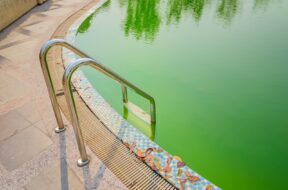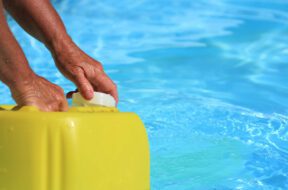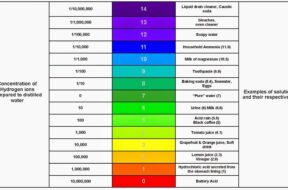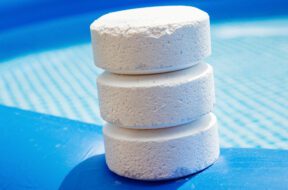
Want to learn more about algaecide? Read on to find out when to add algaecide to your pool maintenance routine and other helpful tips.
Pool Water Delivery Quick Answers:
Where can I get water to fill my pool?
If you’re ready to set up your above-ground pool, inground swimming pool, or hot tub, that question is square one.
One option that many pool owners consider is having water delivered by a local pool water provider. But what should you look for in a swimming pool water delivery service? In this article, we’ll explore how much water delivery will cost, what type of water (and how much) you’ll need, what you should know about pool maintenance, and how to reduce water loss and more.
So what kinds of water are available for delivery? The availability will vary depending on where you live, as well as what your local water companies choose to offer. Many services offer potable drinking water delivery. Potable water is perfectly fine to use in a pool or hot tub, but you’ll have to test it and treat it before swimming in it. On the other hand, some companies explicitly deliver municipality water, which also requires testing and treating.
In some instances, you might be able to get pre-chlorinated water delivered to your home. With chlorinated water, you may not have to treat your swimming pool, which will save you time if you’re eager to dive in. Having said that, testing the water to make sure it’s chemically balanced is still crucial.
Swimming pool water delivery exists for a reason! Finding an affordable and feasible pool water source can be a challenge – whether you’re trying to fill an existing swimming pool or just need a top-off. Depending on where you live, there’s a good chance that multiple local companies are available to bring water tanks to your home. The average individual tank can carry from 2,000-8,000 gallons of water.
When you’re ready to call a swimming pool water delivery service, you’ll have to figure out how many gallons you need, especially if this is your first time filling it. In addition to helping you balance your water, Pool Calculator can help here, too. With our pool volume calculator, you can easily estimate how much water your swimming pool needs.
Do you have an oval, round, or rectangular pool? To find how many gallons you need, just enter the shape of your pool along with the width, length, and average depth – it’s as easy as that.
Here is sizing and gallon information for the most common types of pools


Generally, pool water delivery is more expensive than filling a pool with well water. But the exact price per company depends on many factors.
Factors include:
While there are many benefits of swimming pool water delivery, possibly the best part about having a tanker fill your pool is that it’s much faster than filling it with city water or well water using an ordinary pool pump and a garden hose. A bulk water delivery company can fill up a medium-sized swimming pool in just a few hours, whereas a hose might take several days or more. Also, if your area is experiencing a water shortage or a drought, pool water delivery might be your only option.
If you want to dive into your pool sooner than later, paying a bit more to have a water supplier deliver water is probably your best bet. With an outdoor pool, you might not even have to be home when the water tanker gets there. The delivery truck will arrive within a specified time window, drop their hoses into your pool, fill you up, and send you an invoice. As a swimming pool owner, it doesn’t get much easier than that.
Water delivery services are more common than you think. That said, we researched the best water delivery services for cities in California, Texas, Florida, Arizona, New Hampshire, and Connecticut.
As we mentioned, many water delivery services offer potable water or municipal water – some will offer both. Also, you might be able to get pre-chlorinated water for your pool, but some municipalities don’t allow it. This is another reason why calling around to various companies is a good idea. If you live outside of these cities and would like to learn more about the pool water delivery services in your area, we recommend using Yelp to find services to compare.
Any option you choose to fill your pool will come at an expense, whether in the form of an invoice from a delivery company or your city water bill. To save money on filling your swimming pool, we have two suggestions:
Careful maintenance can help you find a pool leak and fix it quickly, and a pool cover will protect your pool from the sun and dramatically slow evaporation.
No matter what type of water you have delivered, you can’t skip testing it – yes, even if it’s pre-chlorinated. We recommend using test strips to check your water chemistry, which will give you the most accurate reading.
With swimming pools and hot tubs, the water needs to be balanced, sanitized, and healthy for swimming. A test will tell you if the water contains bacteria, high levels of minerals, trace heavy metals, and other contaminants. A test will help you find out what chemical additives you’ll need to get your pool into the safe swimming range.
The simplest way to test and balance your pool water is Pool Calculator. Our handy mobile app for desktop, Android, and iOS makes it a breeze to find your total alkalinity, check for calcium hardness, balance your pH levels, stabilize your free chlorine, and more.
Ready to get started? Make your first stop the Pool Calculator app. As we mentioned above, it’s absolutely essential to test and balance your pool water – no matter where it comes from. With Pool Calculator, that daily maintenance is a breeze. That means you spend less time doing math and more time splashing, playing, and sunning beside your backyard oasis.
Sources:
https://www.sciencedaily.com/terms/water_scarcity.htm
https://www.cdc.gov/healthywater/swimming/swimmers/rwi.html
https://www.epa.gov/privatewells/potential-well-water-contaminants-and-their-impacts

Want to learn more about algaecide? Read on to find out when to add algaecide to your pool maintenance routine and other helpful tips.

In this quick guide, we’ll answer the question “can you over shock a pool” and unveil the factors to consider when shocking a pool.

Maintaining both pH and total alkalinity in your swimming pool is important for keeping your pool properly sanitized and non-corrosive. Total alkalinity is to pH what cyanuric acid is to free chlorine. Total alkalinity stabilizes pH levels. The ideal pool pH level is 7.4 to 7.6. The ideal total alkalinity level is 80 to 120 ppm.

The Association of Pool and Spa Professionals recommends free chlorine levels for both swimming pools and hot tubs be kept between 2.0 and 4.0 ppm. However, the Center for Disease Control recommends free chlorine stay above 1 ppm in pools and 3 ppm in hot tubs.